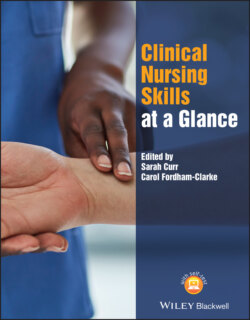Читать книгу Clinical Nursing Skills at a Glance - Группа авторов - Страница 13
Оглавление2 Care planning and the nursing process
Figure 2.1 The nursing process.
Figure 2.2 Henderson's needs theory.
Figure 2.3 Orem's theory of self‐care deficit.
Figure 2.4 Activities of daily living.
Background
Care planning has been a core component of health and social care for many years and was first introduced as part of the nursing process by Ida Jean Orlando (1961). This four‐stage process focused on the initial assessment, care planning, implementation, and then evaluation of the care delivery (Orlando 1961). This is intended as an ongoing, circular, activity (Figure 2.1) until care is no longer required and the patient is discharged from the service.
Since its introduction, the nursing process has evolved, with diagnosis being added by Gebbie and Lavin in 1973. The term diagnosis in nursing has long been debated due to its medical undertones, with Levine coining the term “trophicognosis” (Levine 1965) to replace diagnosis. This is because the term means the art and knowledge of nursing (Levine 1965) and refers to the use of information from the assessment and our pre‐existing knowledge, which allows us to judge the need and thus create an individualised care plan.
Whichever the term used, the provision of individualised care is key to ensuring that high‐quality care that places the patient at the centre is delivered. This also involves recognising that care planning, where possible, should involve the patient and the healthcare professional working together to plan care and set goals that are both desirable and achievable (NHSE 2016).
Influencing Factors
When patients cannot be involved in the care planning, such as in an emergency or with unconscious patients, ensure that you act in their best interests. This will involve establishing if there is an advanced care plan or “living will”. You will also need to establish if legal power of attorney has been granted to an individual and to ensure that person is involved in the process.
Care planning may well differ across settings, but regardless of the setting there will be an opportunity to document the care plan, either digitally or written. This must be done to ensure continuity of care and a timely evaluation.
Professional Approach
When assessing patients, ensure that they are fully informed by explaining the rationale of the assessment and how it will ensure care delivery that meets their individual needs.
While you may be undertaking an individual assessment, planning care will most likely involve other members of the multidisciplinary team (MDT). Ensure that all members of the MDT are involved that are required, undertaking referrals where necessary.
Equipment
Appropriate assessment paperwork.
Patient’s notes.
Care planning paperwork.
Procedure – Assessment
This will involve using the relevant assessment documents within your clinical area. The questions asked may reflect Henderson's needs theory (Henderson 1966) (Figure 2.2), Orem's theory of self‐care deficit (Orem 2001) (Figure 2.3), or Roper, Logan & Tierney's Activities of Daily Living model (Roper et al. 1980) (Figure 2.4). All these models focus on the fact that nursing care is provided while the patient cannot self‐care or meet their daily needs.
Procedure – Diagnosis
The diagnosis involves considering what has been observed and what information has been given during the initial assessment to identify the problem.
The diagnosis focuses on key characteristics that enable the nursing diagnosis to be made.
It is the diagnosis, or diagnoses, that inform the care plan.
Procedure – Care Planning
More than one care plan may well need to be created to ensure that the patient's individualised needs are met.
Care plan charts will most likely be available in your clinical area but the key elements to consider are:What is the issue to be addressed?What interventions will resolve this issue?When would be it be appropriate to evaluate care?
Procedure – Implementation
This is your ongoing care for the patient.
Essentially by performing a thorough assessment, diagnosis and care plan, appropriate, necessary, person‐centred care should be delivered.
Procedure – Evaluation
This is when you review the care plan and determine if the initial issue has now resolved, remained the same, or worsened.
Essentially the evaluation will then lead to an assessment and continuation of the process.
Red Flag
If the patient becomes unresponsive during initial assessment the BLS (Basic Life Support) algorithm and the A–E (airway, breathing, circulation, disability, exposure) assessment should be used.
A holistic assessment may take time as well as several discussions, depending on the patient's condition and priorities of care.
References
1 Gebbie, K. and Lavin, M.A. (1973). Classifying nursing diagnoses. The American Journal of Nursing 74 (2): 250–253.
2 Henderson, V. (1966). The Nature of Nursing. New York: Macmillian.
3 Levine, M.E. (1965). Trophicognosis: an alternative to nursing diagnosis. ANA Clinical Conferences 2: 55–70.
4 NHS England (2016). Personalised Care and Support Planning Handbook: The Journey to Person Centred Care. NHS England: Leeds.
5 Orem, D. (2001). Nursing: Concepts of Practice. St Louis: Mosby.
6 Orlando, I.J. (1961). The Dynamic Nurse‐Patient Relationship, Function, Process and Principles. New York: Putnam Press.
7 Roper, N., Logan, W., and Tierney, A.J. (1980). The Elements of Nursing. London: Churchill Livingstone.
